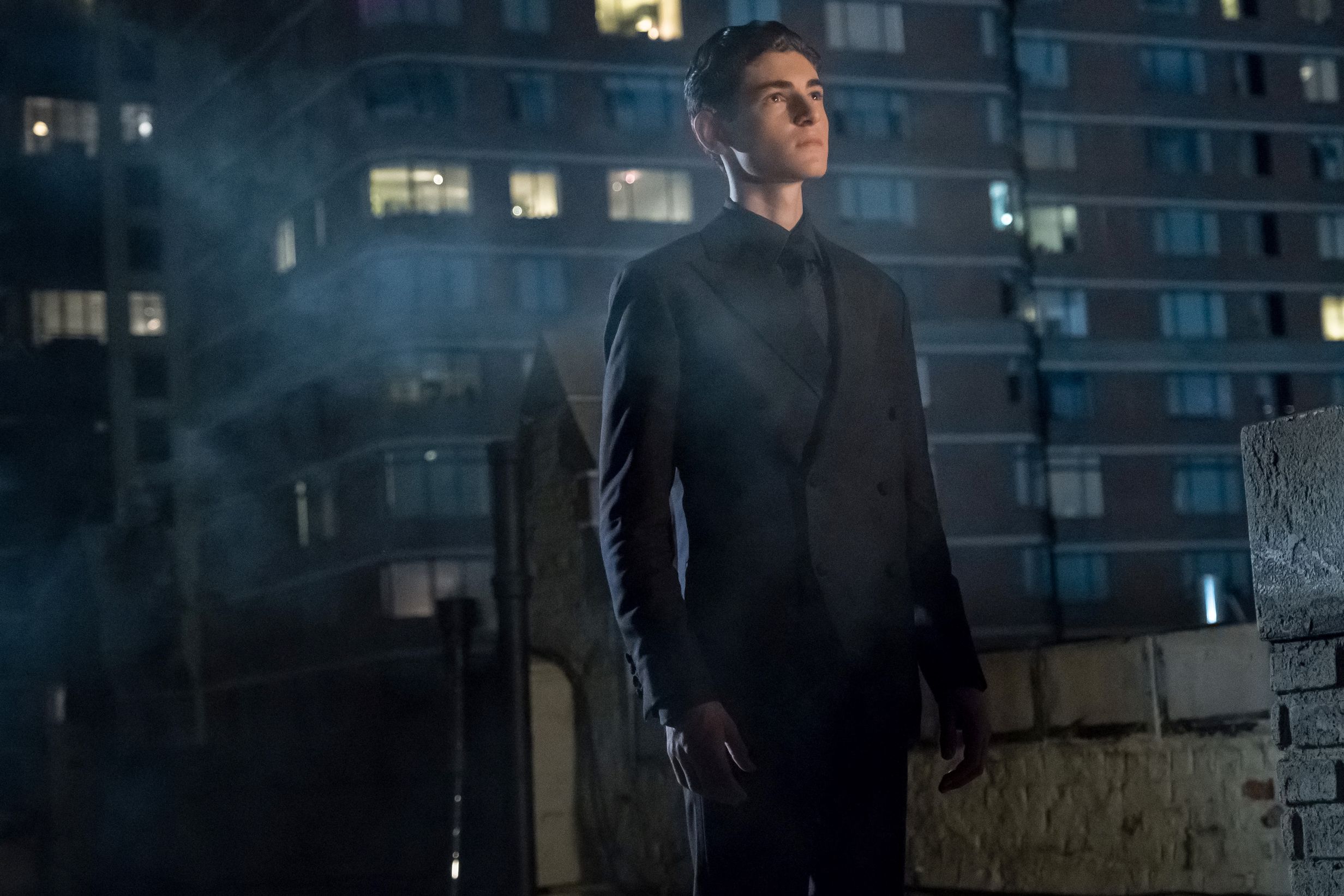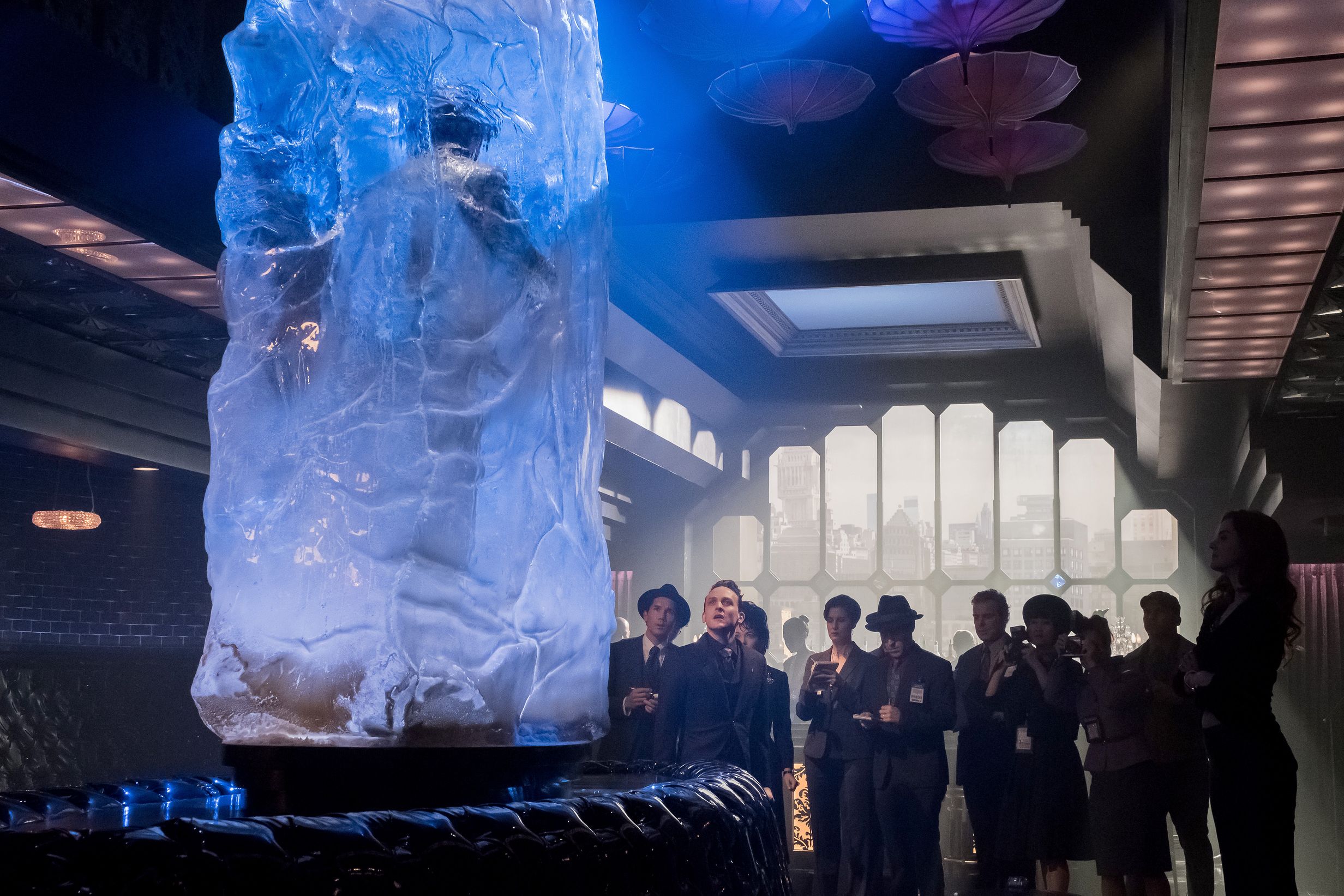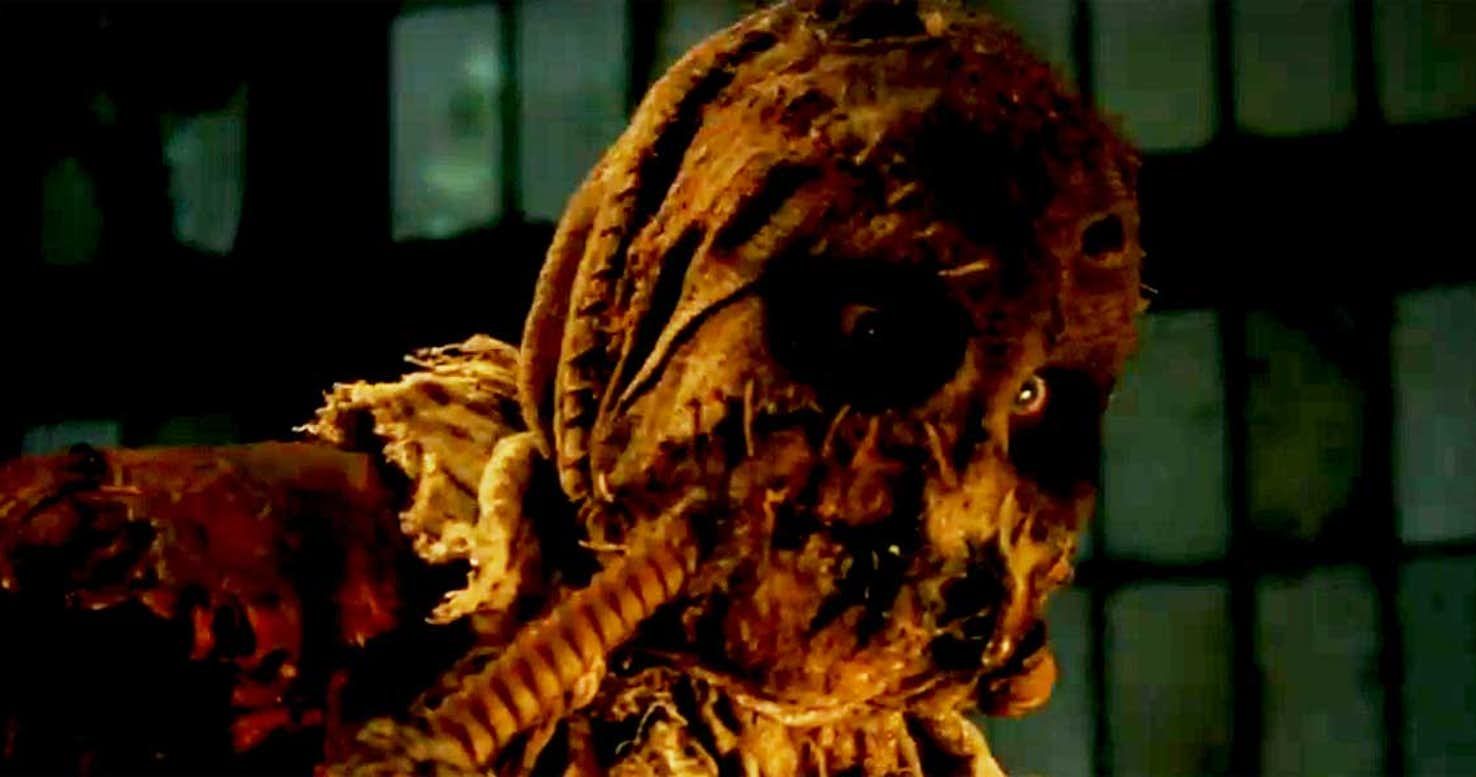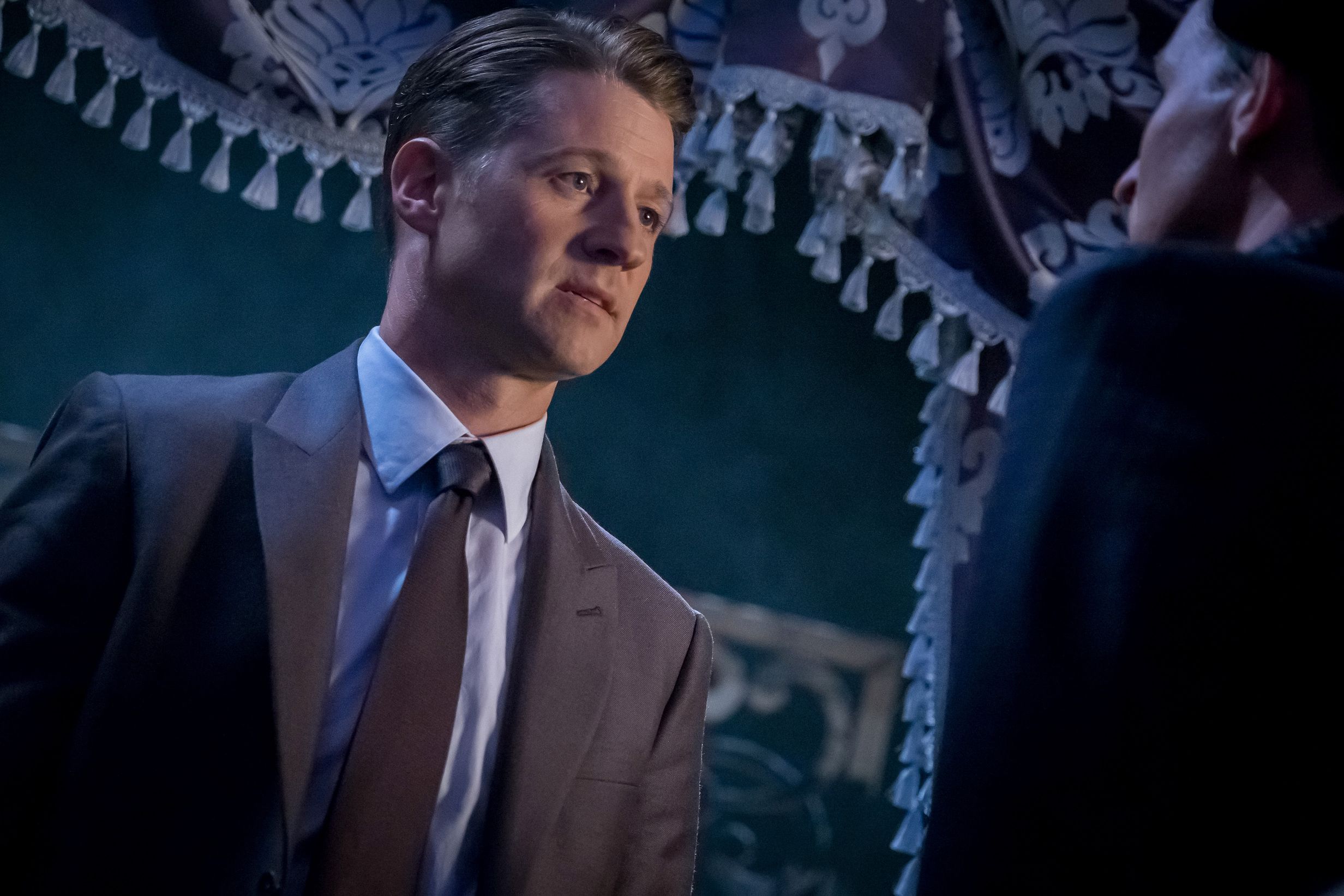The fourth season of Gotham opened with an instantly familiar scene played out ... let's say "in miniature."
On the dark streets of the titular city, standard-issue street thugs circle in on a pair of innocent citizens in an alley. But before the criminals can rob them, from the roofs above jumps a Bat-esque Bruce Wayne, complete with black cowl and barking angry voice. Her dispatches the crooks, only to find that one is carrying a card that supposedly grants him the right to commit crimes in Gotham. And all the while, Ra's Al Ghul watches from the shadows.
RELATED: Here's What You Need to Know For Gotham Season 4
All told, this taste of "Bat-Teen Begins" kills a few birds with one stone. It's a cold open not only for the episode but also for the major arcs in the weeks ahead (Penguin's scheme to "legalize crime") and across the whole season (Al Ghul's machinations). It's also a thematic marker – showcasing young Bruce's shift into crime-fighting mode as this season's "A Dark Knight" subtitle promises. But maybe more importantly than either of those, it was a fun scene that pulled together the disparate elements at play in a way that feels part and parcel of the Batman's world.
Because, against all odds, "Pax Penguina" was a good hour of superhero television. It's the rare episode of Gotham that showed off the series' black humor strengths and found a way to play with various elements of the comic character's history. And while there were still plenty of rough spots along the way (even that cold open raises the question of how Bruce became a roof-jumping fighter, or who told him that stupid mask looked good), this still bodes well for the show eventually delivering a decent season.
The episode threads together all the important storylines impressively, but it's still important to take each of the main threads in their own turn – starting with the Penguin's scheme that gives the episode its name. Since the end of last season, Oswald Cobblepot has apparently reasserted his dominance on both the underworld and the mayor's office he no longer holds by dropping crime rates with his "licensing" plan. But beyond setting up Oswald as an immediate foil for the heroes, the fun of this side of the show is watching classic villains grow in their personas and clash with Batman '66-style glee.
RELATED: How Gotham Season 4 Can Be Saved From Itself
On one hand, we have Selina Kyle and her new mentor Tabitha Galavan living like stray cats. The show continues to evoke Michele Pfeiffer's version of Catwoman in young Selina's impressive fight scenes, and like all of Gotham's references to Bat-media past, this is on the nose but fan-servicey enough to delight. On the other, Penguin's right-hand killer Mr. Zsaz has stepped up as a rare original contribution to the Bat-canon. Unlike the boilerplate psycho killer of the comics, this Zsaz is increasingly sassy and silly in the hands of Anthony Carrigan, and the actor's "last word" statements are some of the most winning moments in the episode. But not to be outdone in the "classic foe clash," Ivy Pepper is lurking in the background as a potential turncoat to keep things interesting in the weeks ahead.
On the flipside of these cartoon crooks, the episode offers up the Merton Gang. This low-level band of robbers that refuses to go along with the Penguin's licensing rule is mostly just here to set up the birth of the Scarecrow. But while past seasons of Gotham primarily offered mobster clichés for these kinds of roles, the Merton crew has a little more personality, thanks largely to the casting of Steve Buscemi's brother (yup) Michael as Merton himself. His spitting, snarling and just-a-little-bit-weaselly performance adds a lot to the conflict between super-criminals and everyday robbers.
Page 2: [valnet-url-page page=2 paginated=0 text='We%20Want%20Jim%20FREAKING%20Gordon']
But the gang is in the premiere because of its plan to whip up a fear toxin with the help of a teenage Jonathan Crane, who's been in Arkham Asylum since Season 1. Scarecrow's inclusion in the season has long been promoted, and his full birth at the end of the episode is expected. In fact, the entire appearance of the character feels a bit flat just because Gotham leans so, so hard on the Batman Begins version of the character. The look, the voice and the effects surrounding the fear toxin are ripped directly from Christopher Nolan, and they work OK as pastiche ... but for now the bit players are stealing the show here in the best way.
If only someone would steal the show from Jim Gordon. To his credit, Ben McKenzie threw more personality into the G.C.P.D.'s white knight than he normally gets to do – particularly in the episode's best scene where Bruce pulls the vanishing act. But all the problems this show has always had with the police-work aspect were on full display here. The "investigation" into both Penguin and Crane was a dead-on-arrival procedural plot with no real mystery elements. Harvey Bullock has nothing to do but play Basil exposition, and, worst of all, Gordon still has no moral compass. He's essentially ready to give up on fighting Penguin's policies after getting worked over by corrupt cops, until Bruce appears to remind him there are more ways to fight. We want Jim Gordon to be Jim Freaking Gordon here. Let him stand up and fight because he's a fighter. Let him take down the corruption ahead of him, the Chicago way. That the show continually drops the ball on this, is its biggest flaw (and it has a lot of flaws).
RELATED: Bruce Wayne Won't Become Batman on Gotham ... "Probably"
On the better heroic track was Bruce's story. In an episode where most forces are at a crossroads, the young vigilante is torn between his desire to get out and deliver capital-J JUSTICE with his fists or (as Alfred recommends) play the long game of patience and training. It's the most clear-eyed objective Bruce has ever been given on this show, and it allows for all sorts of fun moments ripped from the Bat-canon as issues of Bruce as a mask mix with the surprisingly winning teen-romance scenes. Defenders of Gotham have always claimed the point of the show is that it doesn't have to be a Batman prequel, but the screen doesn't lie when it shows us how much better this series can be when it leans hard into its comic roots, with Bruce at its center.
And if there was anything that held the Gotham premiere together as various forces clashed over fear toxin in Penguin's new club, it was the show's willingness to cling to Batman adaptations of the past. Aside from the Nolan-esque Scarecrow and the comic-ready vanishing acts, the episode dropped reference after reference. When we smash-cut from fight scene to the Iceberg Lounge's big party, the transition blare of a trumpet evoked Adam West's "Biff! Bam! Pow!" moves in the best way. And the gaggle of reporters who follow Penguin around even made something fun out of a piece of the Joel Schumacher films. Combine that with rafts of oddball-cartoon supporting players like Mr. Penn and Warden Reid (played by classic "I know that guy" actor Damian Young, whom we've loved since The Adventures of Pete & Pete), and Gotham has a cartoony formula working for it at the moment.
It's way, way, way too early to say whether Season 4 of Gotham can finally deliver on the show's eternally vexing potential, but so far so ... OK.




